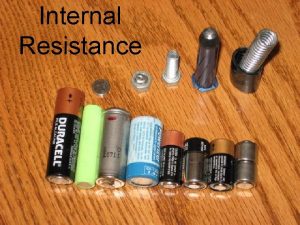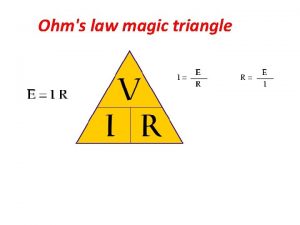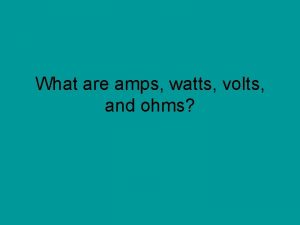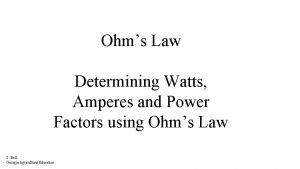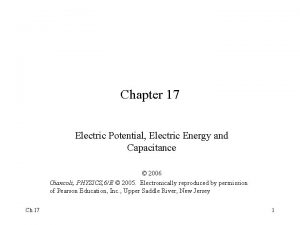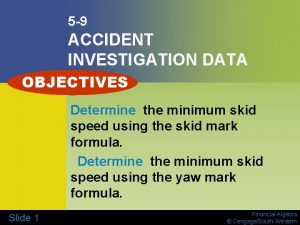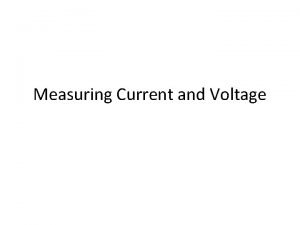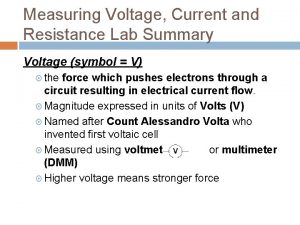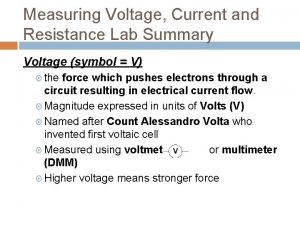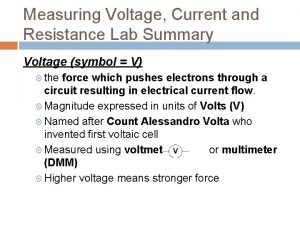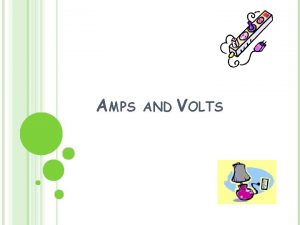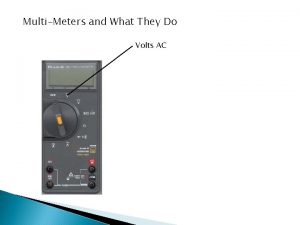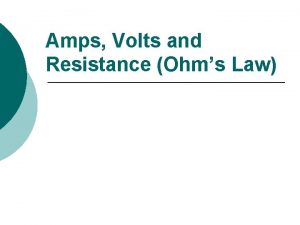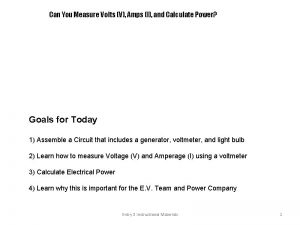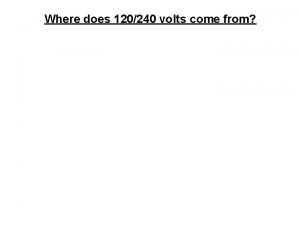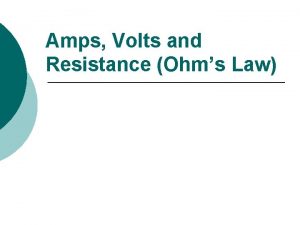Voltage Investigation 3 Measuring Voltage Part 1 Volts


















































- Slides: 50

Voltage Investigation 3

Measuring Voltage Part 1


Volts What makes electricity move through a circuit? Electricity is a flow of electrons. The flow of electrons is called a current. Electrons move when a force is applied to them. The force moving the electrons is called voltage. When you hear someone mention the voltage of an electric source, they are talking about the amount of push available to move current through a circuit.

Volts Voltage in a circuit is sometimes compared to pressure in a water system. The greater the pressure, the more work you get out of the system. http: //www. fossweb. com/modules. MS/kit_mul timedia/Electronics/content/te_4_contents. ht m › Technical manual › Voltage and batteries

Voltmeter Turn the rotary switch to the 20 V setting. At this setting, the voltmeter can measure voltage between 0 and 20 V.

Voltmeter Set up a circuit as shown and close the switch. Voltage is ALWAYS measured with current flowing through the circuit. Touch the 2 probes to the 2 sides of a component to measure voltage drop. The red probe goes on the positive side of the component. Reminder: Do not move the switch on the meter to measure resistance while you are working with electrified circuits!

Voltage drop The difference in the amount of voltage on the 2 sides of a component is what voltage measures. The voltmeter measures the amount of voltage “used” by a component. The amount of voltage used by a component is called a voltage drop. We will always refer to a voltmeter reading as a volt drop.

Voltmeter Inquiry – 8 minutes Voltage drop across the poles of your battery across a lamp connected directly to a battery a lamp is in series with a 75 Ω resistor a lamp is in series with a 330 Ω resistor across one lamp across two lamps in series across two lamps in parallel across three lamps in parallel

How to Record Voltage Draw a schematic of your circuit. Measure the voltage drop across a component. Write the voltage drop in a circle near the component symbol on the schematic. Draw 2 lines from the sides of the circle to the schematic showing where you placed the 2 probes OR write the voltage on a short line next to the component.

Recording Voltage Drops Lab book – p. 11 Measuring Voltage Drops in 4 Circuits. Build the circuits. Measure the voltage drops. Use your lab books to record voltage drop.

Share Discoveries

Summary Batteries have the highest voltage drop. The lamp drops more voltage when it is bright. The switch doesn’t drop any voltage when it is closed, but it drops a lot of voltage when it is opened.

Notes Voltage is what moves current through a circuit. Voltage is like force – a push or a pull. When the electricity is pushed through some components, like resistors and lamps, the amount of available push is reduced. We can measure how much the available push is reduced with a voltmeter. The difference in the amount of voltage on the 2 sides of a component is what he voltmeter measures. We call that reduction in voltage a volt drop.

Clean up Turn in lab book – Measuring voltage Drops in Four Circuits. Secure battery leads Return components to the bag and inventory. Return all materials to the materials station.

Resistance/Voltage Relationship Part 2

Quick Write On your Study Guide Sheet Part 2 How do you explain the voltage drop across a lamp in a circuit?

Share with the class.

Lab book p. 7 – Revisit Resistor Investigation The greater the resistance in series with a lamp, the dimmer the lamp glows. Repeat the series of investigations with the resistors (75, 150, 330 and 1000 Ω), but this time measure the voltage drop across the lamp and resistor in each circuit. ADD A COLUMN Use lab book – Resistor/Voltage Investigation (p. 12) to record your data. Complete the task in 15 minutes.

How can you make a resistor with 0 Ω of resistance? Use the copper wire

Observations The larger the resistor, the greater the voltage drop. The sum of the voltage drops in a circuit equals the voltage at the source.

Lab book p. 12 Is there a pattern in the amount of voltage drop across the resistor? The greater the resistance, the greater the voltage drop across the resistor. Is there a pattern in the amount of voltage drop across the lamp? The greater the resistance, the less the voltage drop across the lamp. How do these voltage drop patterns relate to the size of the resistor in the circuit with the lamp? As resistance increases, the voltage across the resistor increases, and the voltage across the lamp decreases. Add up the lamp and resistor voltages for each resistor. Is there a pattern? The sum of the voltage drops in the circuit equals the available voltage across the terminals of the battery.


Clean up Secure battery leads Return components to the bag and inventory. Return all materials to the materials station.

Resistors “Sharing” Voltage Part 3

Review The greater the resistance, the greater the voltage drop across the resistor. The greater the resistance, the less the voltage drop across the lamp. As resistance increases, the voltage across the resistor increases, and the voltage across the lamp decreases. The sum of the voltage drops in the circuit equals the available voltage across the terminals of the battery.

Task Today’s circuits will only contain resistors and wires as components. Your task is to find out what share of the voltage drop each resistor is responsible for.

Procedure Set up a series circuit with 3 1000 Ω resistors only. Measure and record the voltage drop across each resistor. Record and organize your results. You have 8 minutes to complete the task.

Discuss What is the total resistance in the 3 resistor circuit? 3000 Ω This means that 3000 Ω equal 100 % of the resistance in the circuit. What percentage of the resistance is contributed to one of the resistors? Ω 1000 Ω X 100 = 33. 3% 3000 Ω

Discuss What is the total voltage available in the circuit? About 8 volts. Then how much voltage is dropped by resistor 1? About 2. 7 volts What is the percentage of voltage dropped by resistor 1? 2. 7 V X 100 = 33. 3% 8 V

Lab book – Percentage of Resistance and Voltage Calculate the percentages using your data.

Outcomes - Notes The sum of the percentages of resistance imposed by the individual resistors equals 100%. The sum of the percentages of voltage drop across the resistors equals 100%. The percentage of resistance imposed by a resistor is equal to the percentage of the voltage it drops.

Assignment - Terms Terminals (positive and negative Insulator Open circuit Schematics Closed circuit Resistors Current Ohms Direct current Voltage Series circuit Multimeter Parallel circuit Potentiometer Conductor Voltage drop Short circuit

Assignment Resource Book – Read The Three Great Truths of Electricity.

Break Point

Lab book p. 14 Investigate with 6 Resistors Put all 6 resistors into one series circuit (75 Ω, 150 Ω, 330 Ω, and three 1000 Ω. ) Record the total resistance. Calculate the percentage of resistance contributed by each resistor. Measure and record the voltage drops across each resistor. Calculate the percentage of voltage drop contributed by each resistor. Complete the data chart.


What is the relationship between the percentage of resistance imposed by a component and the percentage of voltage drop associated with that component? The percentage of resistance imposed by a component is equal to the percentage of the voltage dropped by that component.

Great Truths of Circuitry #1 The sum of the component voltage in a series circuit is equal to the voltage of the source. #2 The greater the resistance of a resistor, the greater the voltage it drops. Larger resistors cause large voltage drops; small resistors cause small voltage drops. #3 In a series circuit, the percentage of resistance contributed by a component is equal to the percentage of voltage dropped by that component.

Create a poster for one of the Great Truths of Circuitry

Clean up Secure battery leads Return components to the bag and inventory. Return all materials to the materials station.

Series Circuit Exercises Part 4

Response Sheet – Lab book p. 15 - Voltage Read the text and respond to the ideas presented. Be sure to use complete sentences. Turn in your response sheet when finished.

Lab book - How Do Resistors Divide Voltage? p. 17

Lab book - How Do Resistors Divide Voltage? Work on this sheet with your team.

How Do Resistors Divide Voltage?

How Do Resistors Divide Voltage?

Voltage Response Sheet Review The first Great Truth is about voltage, not resistance; it states that the sum of the voltage drops equals the voltage of the source. The second great truth says that the larger the resistance a component imposes in a series circuit, the greater the voltage drop.

Terms Crossword

Midsummative Exam 3
 Electron volt to volt
Electron volt to volt Electron charge in ev
Electron charge in ev Coulombs to volts
Coulombs to volts Coulombs to volts
Coulombs to volts Lost volts
Lost volts Volts to ev
Volts to ev Compliance with commands given by an authority figure
Compliance with commands given by an authority figure Force magic triangle
Force magic triangle Igcse circuit symbols
Igcse circuit symbols Watts volts amps ohms
Watts volts amps ohms Engineering notation units
Engineering notation units Ohms pie chart
Ohms pie chart Unit of potential energy
Unit of potential energy Nuts and volts hunger games
Nuts and volts hunger games Peak-to-peak voltage formula
Peak-to-peak voltage formula 13800 volts in metric notation
13800 volts in metric notation Voltage to coulombs
Voltage to coulombs Difference between phase voltage and line voltage
Difference between phase voltage and line voltage What are the objectives of earthing
What are the objectives of earthing Low voltage vs medium voltage
Low voltage vs medium voltage Ac voltage controller output voltage formula
Ac voltage controller output voltage formula Brainpop ratios
Brainpop ratios 미니탭 gage r&r 해석
미니탭 gage r&r 해석 Technical descriptions
Technical descriptions Part whole model subtraction
Part whole model subtraction Parts of a bar
Parts of a bar Part to part ratio definition
Part to part ratio definition The phase of the moon you see depends on ______.
The phase of the moon you see depends on ______. English language nea investigation
English language nea investigation Continuous mortality investigation
Continuous mortality investigation Oos investigation mhra
Oos investigation mhra Weather investigation
Weather investigation Megaloblastic anemia vs pernicious anemia
Megaloblastic anemia vs pernicious anemia Geotaphonomy
Geotaphonomy Feasibility study in sdlc
Feasibility study in sdlc Georgia dfcs investigation protocol
Georgia dfcs investigation protocol Investigation of megaloblastic anemia
Investigation of megaloblastic anemia Criminal investigation lesson plans
Criminal investigation lesson plans Vcaa chemistry study design
Vcaa chemistry study design Personal investigation a level art
Personal investigation a level art Parts of an investigation
Parts of an investigation Surface area investigation
Surface area investigation 2106 crime scene investigation
2106 crime scene investigation Is ketchup homogeneous or heterogeneous
Is ketchup homogeneous or heterogeneous Lockheed martin investigation
Lockheed martin investigation Crime scene note taking
Crime scene note taking Investigation for reservoir planning
Investigation for reservoir planning Démarche d'investigation
Démarche d'investigation Investigation for thyroid
Investigation for thyroid 5-9 accident investigation data answers
5-9 accident investigation data answers Ex officio investigation
Ex officio investigation




